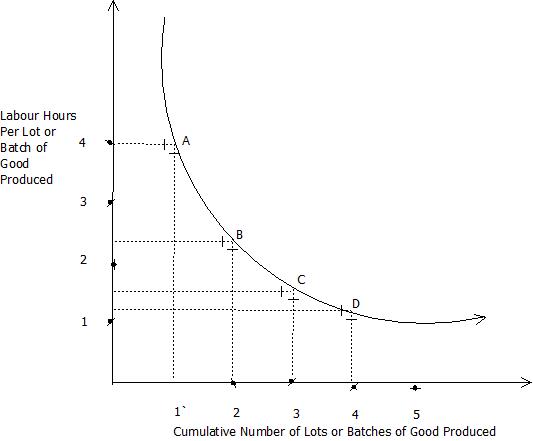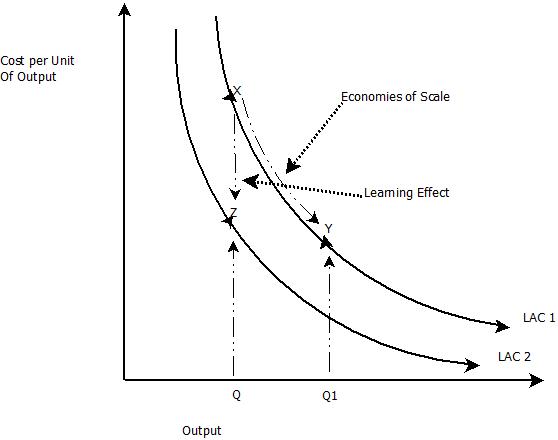Learning Curve Effect
MICROECONOMICS

|
Learning Curve Effect |

|
Introduction |
Long Run Cost theory suggests that a firm observes fall in its average cost of production in the long run on account of the firm enjoying benefits of ‘Economies of Scale’ and ‘Increasing Returns to Scale’ in the long run. However, the factor of Economies of Scale cannot be the only reason for the fall in the average cost of production as output of a firm increases. There is another phenomenon which also contributes to the fall in the average cost of production as the output of a firm increases. This phenomenon can be termed as 'Learning Effect'. In this module the concept and application of Learning Curve Effect has been covered in detail.
| Understanding Learning Effect |
Learning Curve Effect
Learning Curve measures the relation between increase in per worker productivity (leading to decrease in per unit labor cost at fixed prices) associated with an improvement in labor skills from on the job experience. [1]
In other words, Learning Effect leads to fall in the cost of production per unit because with the increased involvement in the production process Labor and Managers become more and more familiar with the production process. This leads to improvement in their efficiency level. Here ‘Efficiency’ means greater amount of output generated per labor unit over the same amount of input of labor hours in the process of production. This happens on account of following factors:
- The labor units or the workers who are engaged in the production or manufacturing process become familiar with the process of production with the passage of time. Thus, they require less time or labor hours to generate same amount of output which they were earlier producing by using more labor hours.
- Managers who are involved in the management and scheduling of the production process also get familiar with the process and are thus in better position to use the resources at their disposal in better manner as well as scheduling the production process more efficiently thus leading to more output for the same amount of input.
Following Diagram is representation of the Learning Curve Effect:
In the above diagram on the X axis, we have taken the number of lots or batches of Good produced and on the Y axis we are considering the labor hours required per lot of Good produced. It is clear from the diagram that the labor hours required to produce each lot is higher when the firm is producing the first or initial few lots or batches of good. The labor hours required per lot of production to produce the second lot or later lots on the other hand is lower. As per the above depicted diagram (figure 1) the labor hours required to produce the first lot is close to four hours. While the labor hours required for producing the second lot is close to two hours. The labor hour requirement per lot further goes down by the time company is producing the third and the fourth lot of the Good or Product. The Learning Curve effect can be further explained by using the following data table:
| Labor Hours to Produce Good | Number of Batches Produced | Average Number of Labor Hours Required to a Batch | Average Cost of Labor (If Labor Cost is Rs. 500 per Labor Hour) |
|---|---|---|---|
| 10 | 1 | 10 | 5000 |
| 18 | 2 | 9 | 4500 |
| 24 | 3 | 8 | 4000 |
| 28 | 4 | 7 | 3500 |
| 30 | 5 | 6 | 3000 |
| 36 | 6 | 6 | 3000 |
From the above table it is clear that the average number of hours required to produce a batch of particular good say 'X' is going down on account of Learning Curve Effect. If we assume that labor cost per hour is Rs. 500 and this labor cost per hour stays fixed, then the average cost of labor required to produce a batches of good 'X' is goes down on account of increased output from the same amount of labor hour input. Thus, as per the table, the Average Labor Cost per batch is going down from Rs. 5000 to Rs. 3000 by the time the company is producing sixth batch of Good X and this happens on account of Learning Curve Effect.
Aman and Asad are good friends. Aman is not very familiar with computers and is not used to typing documents with help of computer keyboard. However, his friend Asad is an experienced computer operator.Thus, the time taken by Aman to type a 500 word document on the personal computer is 1 hour while the time taken by Asad to type the same document of the personal computer is 10 minutes. The factor that has resulted in higher efficiency of Asad is the ‘Learning Effect’. As, Asad is used to working on the personal computer and he is familiar with the use of keyboard, the time required by him to type the document is much less than that of Aman. If Aman starts using personal computers on more regular basis then the time required by him to type such 500 word document will also reduce on account of the ‘Learning Curve Effect’.
| Differance between Learning Curve Effect and Impact of Economies of scale on a Firm |
Learning Curve Effect Vs Economies of Scale
Economies of Scale are outcome of long run production under which the scale of the operation of the firm increases. Economies of Scale lead to fall in long run average cost of production as the output of a firm increases. On the other hand ‘Learning Effect' is possible both in the short run as well as the long run production. This is because the ‘Learning Effect’ is outcome of the increased familiarity of Labor or Manager with the production processes. The increased familiarity with the production process leads to improved efficiency or more output for the same amount of input in terms of labor hours required in the production process and similar other factors. The difference between ‘Economies of Scale’ and ‘Learning Effect’ can be understood with help of following diagram:
Movement from X to Y indicates the impact of ‘Economies of Scale’ on the average cost of production. ‘Economies of Scale’ are leading to the fall in long run average cost of production, whereby, the per unit cost of production is declining as the firm increase its output from ‘Q’ to ‘Q1’. The impact of ‘Economies of Scale’ on the Cost is leading to movement from point X to Y along the same long run average cost curve-‘LAC 1’. On the other hand movement from the point X on ‘LAC 1’ to point Z on ‘LAC 2’ indicates ‘Learning Effect’. Under the impact of learning curve effect the cost per unit registers a decline and leads to movement from ‘LAC 1’ to ‘LAC 2’ indicating that on account of ‘Learning Effect’ less cost per unit is required to produce same quantity that is ‘Q’ of the Good.
| Measurement/Computation of Learning Curve Effect |
One of the ways to measure learning curve effect can be by using the following equation:
[math] Y_{n} = K_{n}^{log_2 b}[/math]
Where;
- [math] Y_{n}[/math] is of equal to the number of Direct labour hours required to produce [math] n^{th}[/math] number of unit of the Good under consideration
- [math] K [/math] is the Direct number of labour hours required to produce first unit of Good
- [math] n [/math] is the number of units of Good produced
- [math] b [/math] is Learning Percentage

|
Results |
- Learning Curve measures the relation between increase in per worker productivity (leading to decrease in per unit labor cost at fixed prices) associated with an improvement in labor skills from on the job experience.
- Learning Effect leads to fall in the cost of production per unit because with the increased involvement in the production process Labor and Managers become more and more familiar with the production process. This leads to improvement in their efficiency level. Here ‘Efficiency’ means greater amount of output generated per labor unit over the same amount of input of labor hours in the process of production.
- Differance between the Economies of Scale and Learning Curve Effect is as follows: Economies of Scale are outcome of long run production under which the scale of the operation of the firm increases. Economies of Scale lead to fall in long run average cost of production as the output of a firm increases. On the other hand ‘Learning Effect' is possible both in the short run as well as the long run production.
Self Assessment Questions on Learning Curve Effect
[To Attempt Quiz on Learning Click Here]

|
Further Readings |
- Micronomics by Robert S. Pindyck, Daniel L. Rubinfeld and Prem L. Mehta, Pearson Publication
- Modern Microeconomics by A. Koutsoyiannis, ELBS Publication
- Managerial Economics by D.N. Dwivedi, Vikas Publication
- Managerial Economics by Petersen and Lewis, Prentice-Hall Publication
Cite error: <ref> tags exist, but no <references/> tag was found






